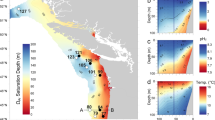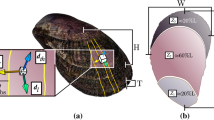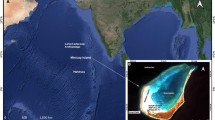Abstract
Anthropogenic inputs of CO2 are changing ocean chemistry and will likely affect calcifying marine organisms, particularly aragonite producers such as pteropods. This work seeks to set a benchmark analysis of pteropod shell properties and variability using nanoindentation and electron microscopy to measure the structural and mechanical properties of Subantarctic pteropod shells (Limacina helicina antarctica) collected in 1998 and 2007. The 1998 shells were collected by a sediment trap deployed at 2000 m, 47°S, 142°E, and the 2007 shells were collected using nets from mixed-layer waters in the region (44°–54°S, 140°–155°E). Transmission electron microscopy revealed that the shells are composed of a polycrystalline structure, and no obvious porosity was visible. The hardness and modulus of the shells were measured using shell cross-section nanoindentation, across various regions of the shell from the inner to outer whorl. No change in mechanical properties was found with respect to the region of the shell cross-section probed. There was no statistically significant difference in the mean modulus or hardness of the shells between the 1998 and 2007 data sets. No major changes in the mechanical properties of these pteropod shells were detected between the 1998 and 2007 data sets, and we discuss the possible biases in the sampling techniques in complicating our analysis. However, quantifying the mechanical properties and microstructure of calcified may still provide insights into the responses of calcification to environmental changes, such as ocean acidification.






Similar content being viewed by others
References
Bednaršek N, Tarling GA, Bakker DCE, Fielding S, Jones EM, Venables HJ, Ward P, Kuzirian A, Lézé B, Feely RA, Murphy EJ (2012a) Extensive dissolution of live pteropods in the Southern Ocean. Nat Geosci 5:881–885. doi:10.1038/NGEO1635
Bednaršek N, Tarling GA, Bakker DCE, Fielding S, Cohen A, Kuzirian A, McCorkle D, Leze B, Montagna R (2012b) Description and quantification of pteropod shell dissolution: a sensitive bioindicator of ocean acidification. Glob Change Biol 18:2378–2388. doi:10.1111/j.1365-2486.2012.02668.x
Bijma J, Spero HJ, Lea DW (1999) Reassessing foraminiferal stable isotope geochemistry: impact of the oceanic carbonate system (experimental results). In: Fisher G, Wefer G (eds) Use of proxies in paleoceanography. Springer, Berlin, pp 489–512
Bijma J, Hönisch B, Zeebe RE (2002) Impact of the ocean carbonate chemistry on living foraminiferal shell weight. Geochem Geophys 3:1064. doi:10.1029/2002GC000388
Borjes AV, Tilbrook B, Metzl N, Lenton A, Delille B (2008) Inter-annual variability of the carbon dioxide oceanic sink south of Tasmania. Biogeosciences 5:141–151. doi:10.5194/bg-5-141-2008
Bray S, Trull T, Manganini S (2000) SAZ project moored sediment traps: results of the 1997–2007 deployments. Antarctic cooperative research centre report no. 15, Hobart, Tasmania, Australia
Bruet BJF, Qi HJ, Boyce MC, Panas R, Tai K, Frick L, Ortiz C (2005) Nanoscale morphology and indentation of individual nacre tablets from the gastropod mollusc Trochus niloticus. J Mater Res 20:2400–2419. doi:10.1557/JMR.2005.0273
Comeau S, Gorsky G, Jeffree R, Teyssie JL, Gattuso JP (2009) Impact of ocean acidification on a key Arctic pelagic mollusc (Limacina helicina). Biogeosciences 6:1877–1882. doi:10.5194/bg-6-1877-2009
Comeau S, Alliouane S, Gattuso JP (2012) Effects of ocean acidifcation on overwintering juvenile Arctic pteropods Limacina helicina. Mar Ecol Prog Ser 456:279–284
Doerner MF, Nix WD (1986) A method for interpreting the data from depth-sensing indentation instruments. J Mater Res 1:601–609. doi:10.1557/JMR.1986.0601
Doney SC, Fabry VJ, Feely RA, Kleypas JA (2009) Ocean acidification: the other CO2 problem. Mar Sci 1:169–192. doi:10.1146/annurev.marine.010908.163834
Espinosa HD, Juster AL, Latourte FJ, Loh OY, Gregoire D, Zavattieri PD (2011) Tablet-level origin of toughening in abalone shells and translation to synthetic composite materials. Nat Commun 2:173. doi:10.1038/ncomms1172
Fabry VJ, McClintock JB, Mathis JT, Grebmeier JM (2009) Ocean acidification at high latitudes: the bellwether. Oceanography 22:160–171. doi:10.5670/oceanog.2009.105
Fischer-Cripps AC (2004) Nanoindentation. Springer, New York
Gattuso J-P, Buddemeier R (2000) Calcification and CO2. Nature 407:311–312. doi:10.1038/35030280
Gattuso J-P, Frankignoulle M, Bourge I, Romaine S, Buddemeier R (1998) Effect of calcium carbonate saturation of seawater on coral calcification. Glob Planet Change 18:37–46. doi:10.1016/S0921-8181(98)00035-6
Harbison GR, Gilmer RW (1986) Effects of animal behaviour on sediment trap collections: implications for the calculations of aragonite fluxes. Deep Sea Res 33:1017–1024. doi:10.1016/0198-0149(86)90027-0
Hare PE, Abelson PH (1964) Proteins in mollusk shells. Report of the Director, Geophysics Laboratory, Carnegie Institution, Washington 63:267–270
Howard WR, Roberts D, Moy AD, Lindsay MCM, Hopcroft RR, Trull TW, Bray SG (2011) Distribution, abundance and seasonal flux of pteropods in the Sub-Antarctic Zone. Deep Sea Res II 58:2293–2300. doi:10.1016/j.dsr2.2011.05.031
Hunt BPV, Pakhomov EA, Hosie GW, Sigel V, Ward P, Bernard K (2008) Pteropods in Southern Ocean ecosystems. Prog Oceanogr 78:193–221. doi:10.1016/j.pocean.2008.06.001
Katti KS, Mohanty B, Katti DR (2006) Nanomechanical properties of nacre. J Mater Res 21:1237–1242. doi:10.1557/jmr.2006.0147
Kleypas J, Buddemeier R, Archer D, Gattuso J, Langdon C, Opdyke B (1999) Geochemical consequences of increased atmospheric carbon dioxide on coral reefs. Science 284:118–120. doi:10.1126/science.284.5411.118
Langdon C, Atkinson MJ (2005) Effect of elevated pCO2 on photosynthesis and calcification of corals and interactions with seasonal change in temperature/irradiance and nutrient enrichment. J Geophys Res Oceans (1978–2012). doi:10.1029/2004JC002576
Lenton A, Tilbrook B, Law RM, Bakker D, Doney SC, Gruber N, Ishii M, Hoppema M, Lovenduski NS, Matear RJ, McNeil BI, Metzl N, Mikaloff Fletcher SE, Monteiro PMS, Rödenbeck C, Sweeney C, Takahashi T (2013) Sea-air CO2 fluxes in the Southern Ocean for the period 1990–2009. Biogeosciences 10:4037–4054. doi:10.5194/bg-10-4037-2013
Lischka S, Riebesell U (2012) Synergistic effects of ocean acidification and warming on overwintering pteropods in the Arctic. Glob Change Biol 18:3517–3528. doi:10.1111/gcb.12020
Lourey MJ, Trull TW (2001) Seasonal nutrient depletion and carbon export in the Subantarctic and Polar Frontal zones of the Southern Ocean south of Australia. J Geophys Res 106:31463–31487. doi:10.1029/2000JC000287
Manno C, Sandrini S, Tositti L, Accornero A (2007) First stages of degradation of Limacina helicina shells observed above the aragonite chemical lysocline in Terra Nova Bay (Antarctica). J Mar Syst 68:91–102. doi:10.1016/j.jmarsys.2006.11.002
Manno C, Morata N, Primicerio R (2012) Limacina retroversa’s response to combined effects of ocean acidification and sea water freshening. Estuar Coast Shelf Sci 113:163–171. doi:10.1016/j.ecss.2012.07.019
McNeil BI, Matear RJ (2008) Southern Ocean acidification: a tipping point at 450-ppm atmospheric CO2. Proc Natl Acad Sci 105:18860–18864. doi:10.1073/pnas.0806318105
Midorikawa T, Inoue HY, Ishii M, Sasano D, Kosugi N, Hashida G, Nakaoka S, Suzuki T (2012) Decreasing pH trend estimated from 35-year time series of carbonate parameters in the Pacific sector of the Southern Ocean in summer. Deep Sea Res I 61:131–139. doi:10.1016/j.dsr.2011.12.003
Moy AD, Howard WR, Trull TW, Bray S (2009) Reduced calcification in modern Southern Ocean planktonic foraminifera. Nature Geosci 2:276–280. doi:10.1038/ngeo460
Mucci J (1983) The solubility of calcite and aragonite in seawater at various salinities, temperatures, and one atmosphere total pressure. Am J Sci 283:780–799. doi:10.2475/ajs.283.7.780
Oliver WC, Pharr GM (1992) An improved technique for determining hardness and elastic modulus using load and displacement sensing indentation experiments. J Mater Res 7:1564–1583. doi:10.1557/JMR.1992.1564
Orr JC, Fabry VJ, Aumont O et al (2005) Anthropogenic ocean acidification over the twenty-first century and its impact on calcifying organisms. Nature 437:681–686. doi:10.1038/nature04095
Pommeranz T, Hermann C, Kühn A (1982) Mouth angle of the rectangular midwater trawl (RMT1+8) during paying out and hauling. Meeresforschung 29:267–274
Riebesell U, Zondervan I, Rost B, Tortell PD, Zeebe RE, Morel FMM (2000) Reduced calcification of marine plankton in response to increased atmospheric CO2. Nature 407:364–366. doi:10.1038/35030078
Rintoul SR, Bullister JL (1999) A late winter hydrographic section from Tasmania to Antarctica. Deep Sea Res I 46:1417–1454. doi:10.1016/S0967-0637(99)00013-8
Roberts D, Howard WR, Moy AD, Roberts JL, Trull TW, Bray SG, Hopcroft RR (2011) Interannual pteropod variability in sediment traps deployed above and below the aragonite saturation horizon in the Sub-Antarctic Southern Ocean. Polar Biol 31:1739–1750. doi:10.1007/s00300-011-1024-z
Roe HSJ, AdeC Baker, Carson RM, Wild R, Shale DM (1980) Behaviour of the Institute of Oceanographic Science’s rectangular midwater trawls: theoretical aspects and experimental observations. Mar Biol 56:247–259. doi:10.1007/BF00645349
Sato-Okoshi W, Okoshi K, Sasaki H, Akiha F (2010) Shell structure of two polar pelagic molluscs, Arctic Limacina helicina and Antarctic Limacina helicina antarctica forma antarctica. Polar Biol 33:1577–1583. doi:10.1007/s00300-010-0849-1
Scurr D, Eichhorn SJ (2006) Analysis of local deformation in indented Ensis Siliqua mollusk shells using Raman spectroscopy. J Mater Res 21:3099–3108. doi:10.1557/jmr.2006.0382
Spero HJ, Bijma J, Lea DW, Bemis BE (1997) Effect of seawater carbonate concentration on foraminiferal carbon and oxygen isotopes. Nature 390:497–500. doi:10.1038/37333
Teniswood CMH, Roberts D, Howard WR, Bradby JE (2013) A quantitative assessment of the mechanical strength of the polar pteropod Limacina helicina antarctica shell. ICES J Mar Sci 70:1499–1505. doi:10.1093/icesjms/fst100
Trull T, Bray S, Manganini S, Honjo S, Francois R (2001) Moored sediment trap measurements of carbon export in the Sub-Antarctic and Polar Frontal zones of the Southern Ocean, south of Australia. J Geophys Res 106:31489–31510. doi:10.1029/2000JC000308
Uthicke S, Momigliano P, Fabricius KE (2013) High risk of extinction of benthic foraminifera in this century due to ocean acidification. Sci Rep. doi:10.1038/srep01769
Zhang T, Yurong M, Chen K, Yurong M, Chen K, Kunz M, Tamura N, Qiang M, Xu J, Qi L (2011) Structure and mechanical properties of a pteropod shell consisting of interlocked helical aragonite nanofibers. Angew Chem 123:10545–10549. doi:10.1002/anie.201103407
Zondervan I, Zeebe RE, Rost B, Riebesell U (2001) Decreasing marine biogenic calcification: a negative feedback on rising atmospheric pCO2. Glob Biogeochem Cycles 15:507–516. doi:10.1029/2000GB001321
Acknowledgments
The authors acknowledge Dr. Thomas Trull for the sediment trap samples, which was supported by the Australian Government through the Department of Industry Cooperative Research Centres Program, the Australian Antarctic Sciences program (AAS #1156) and the Australian Marine National Facility. The SAZ-Sense voyage was supported by the Australian Government through the Department of Climate Change, the Australian Cooperative Research Centres Program and the Australian Antarctic Division (AAS Grant #2720). The authors thank Dr. Karsten Goemann and Dr. Sandrin Feig of the Electron Scanning Facility at the Central Science Laboratory, University of Tasmania, for their assistance with the electron microscopy, the ANFF (ACT Node) for use of the FIB, and Dr. Simon Wotherspoon of the Institute for Marine and Antarctic Studies, University of Tasmania, for assistance with the statistical analysis. JEB is funded by an Australian Research Council Future Fellowship.
Author information
Authors and Affiliations
Corresponding author
Rights and permissions
About this article
Cite this article
Teniswood, C.M.H., Roberts, D., Howard, W.R. et al. Microstructural shell strength of the Subantarctic pteropod Limacina helicina antarctica . Polar Biol 39, 1643–1652 (2016). https://doi.org/10.1007/s00300-016-1888-z
Received:
Revised:
Accepted:
Published:
Issue Date:
DOI: https://doi.org/10.1007/s00300-016-1888-z




